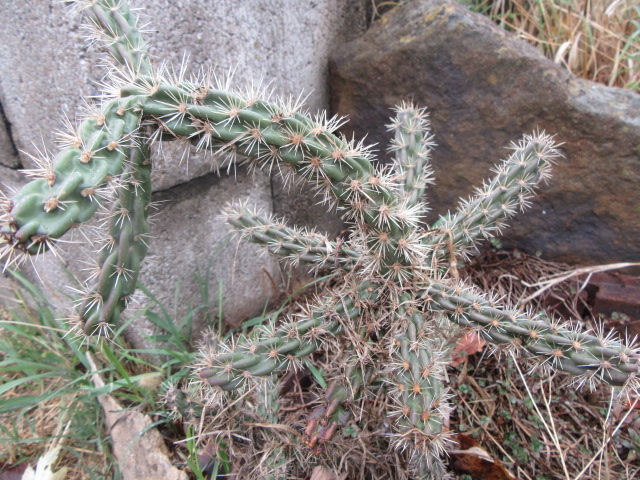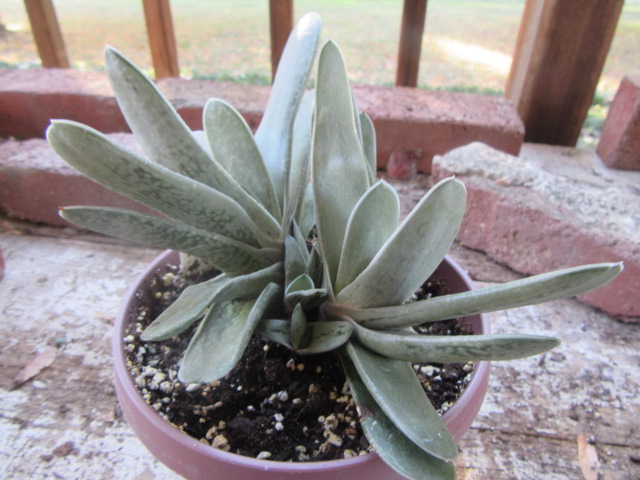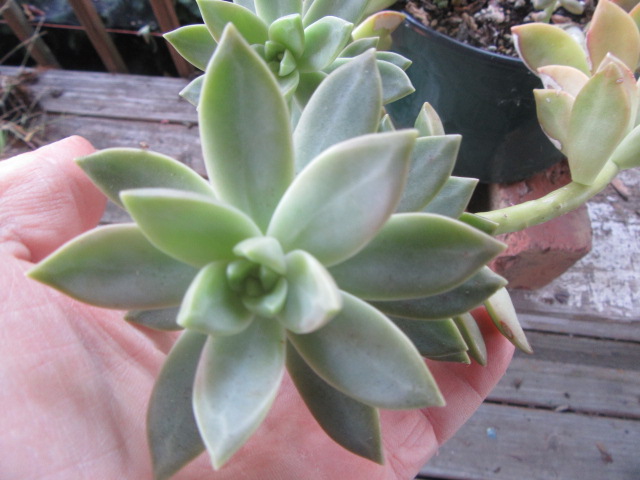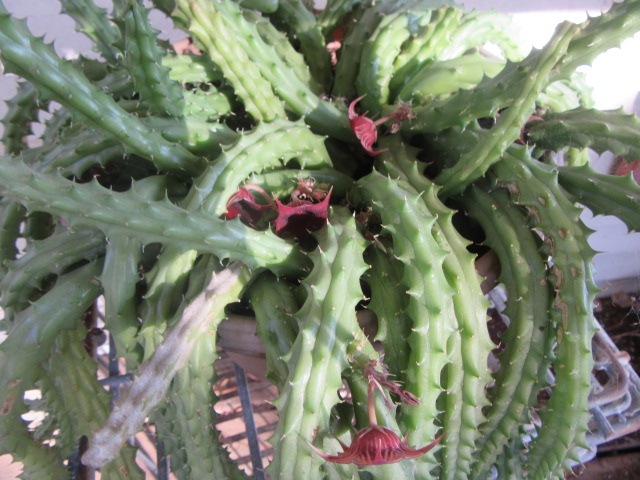
Cylindropuntia imbricata (Tree Cholla) on 10-28-20, #753-1.
Hello everyone! I hope this post finds you well. I don’t want to talk about the weather except to say the “S” is all gone and it is supposed to get up to 42° F today.
The above photo is the Cylindropuntia imbricata (Tree Cholla). I always forget about it, the three Sedums, and the Sempervivum ‘Killer’ that are outside in the bed in the “other yard”. They stay outside, of course, and I suppose the cactus and succulent updates are about the plants I bring inside. But still, I shouldn’t exclude the plants that go through the winter outside… As I was taking the above photo, I started to pick off some grass clippings and leaves that had got stuck in its spines. It said, “Leave it there”, and gave me a little poke to let me know he was serious. Well, it is always serious…
If you want to go to the plant’s own page for more information, click on its name under the photo in green.
<<<<Espostoa melanostele subsp. nana>>>>

Espostoa melanostele subsp. nana (Peruvian Old Lady) at 9″ tall x 2 1/2″ wide on 10-15-20, #747-30.
The Espostoa melanostele subsp. nana (Peruvian Old Lady) is quite interesting. It has grown A LOT since I bought it home from Wal-Mart on February 1, 2016. It was only 2 3/4″ tall x 1 3/4″ wide at the time and now has grown to 9″ tall x 2 1/2″ wide. It would definitely be top-heavy so keeping the pots side-by-side keeps it from falling over. The subspecies name is accepted for this plant and the species is not as hairy.

Espostoa melanostele subsp. nana on 10-15-20, #747-31.
Of course, the most interesting feature of the Peruvian Old Lady Cactus is its hair. This plant may look soft and cuddly, but under the hair are a lot of spines. So you still have to handle it with care.
<<<<Euphorbia mammillaris>>>>

Euphorbia mammillaris (Indian Corn Cob) at 8″ tall on 10-15-20, #747-32.
The Euphorbia mammillaris (Indian Corn Cob, ETC.) is a very interesting plant. I brought this plant home as a cutting on March 29, 2019 when it was quite small. The cutting had a main stem with four side branches on one side which kind of makes it look a little lop-sided. I thought about removing the side branches and letting them grow into four separate plants but so far I haven’t done that. Last October 11 when I moved the plants inside, the main stem measured 5 3/4″ tall and this year it has grown to 8″ tall. Information online says it is a fast grower and it will reach as high as the ceiling. Well, that may take some time.
Euphorbia is one of the most diverse of all genera and includes species of cactus, succulents, perennials, wildflowers, trees, and shrubs… I probably missed something.

Euphorbia mammillaris (Indian Corn Cob) on 10-15-20, #747-33.
I really like the combination of leaves, thorns, and the geometric shapes of the tubercles. I have had a few other Euphorbia species that have been a lot more delicate. You never know when you try a species if it will work out or not.
<<<<Ferocactus wislizeni>>>>

Ferocactus wislizeni at 2 3/8″ tall x 2 3/8″ wide on 10-15-20, #747-34.
The Ferocactus wislizeni is a neat cactus that gets a reddish glow in the sun. It has prominent ribs and long enough spines to keep any cat from sticking its nose where it shouldn’t be. I brought this cactus home from Lowe’s on 3-19-20 when it was just 1 5/8″ tall x 2 1/8″ wide. It has now grown to 2 3/8″ tall x 2 3/8″ wide.
This species was first put in the Echinocactus genus in 1848 then moved to Ferocactus in 1922. Several other species were determined to be synonymous with Ferocactus wislizeni. It is believed that the spines of this species were once used as fish hooks which led to one of its common names, Fishhook Barrel Cactus. I had a similar species of fish hook cactus with much more curved spines but for some reason, it didn’t live long. I haven’t found a replacement yet…

Top view of the Ferocactus wislizeni on 10-15-20, #747-35.
New spines are reddish with a lot of wool on the areoles. Quite neat, I think…
<<<<x Gasteraloe ‘Flow’>>>>

x Gasteraloe ‘Flow’ at 5 1/4″ tall x 10″ wide on 10-15-20, #747-36.
I think x Gasteraloe are great plants and x Gasteraloe ‘Flow’ is no exception. ‘Flow’ is my fourth x Gasteraloe and the only one I have now, but not because the others died… This is one of the first plants I brought home when I “started over” in 2016 but I can’t remember where I got it. Lowe’s or Wal-Mart probably. I don’t have any measurements for it until October 17, 2017, when it measured 4″ tall x 6″wide. It is currently 5 1/4″ tall x 10″ wide which is a little smaller than last year. Hmmm… Well, leaves die and new ones grow so that isn’t uncommon when a plant has reached maturity. This plant flowered last year but not this year. I could have missed it since I was busy, but that is unlikely…
I haven’t really figured out the exact lineage of this plant and there isn’t a lot about that online. Most websites say it is an intergeneric hybrid between Gasteria carinata var. verrucosa and an unknown Aloe species. Others say it is a cross between Gasteria and Aristaloe aristata… The leaf coloration certainly resembles Gasteria carinata var. verrucosa but of course, it grows much more like the Aristaloe aristata (which was previously Aloe aristata).

x Gasteraloe ‘Flow’ with new offsets on 10-15-20, #747-37.
This plant had four nice, good-sized offsets but when I repotted it in September 2018 I gave the offsets their own pots. Well, that didn’t work so well because the offsets aren’t doing so well. In fact, they are now MUCH smaller and barely surviving. ‘Flow’ now has a few more offsets which I will NOT be removing…
<<<<Gasteria ‘Little Warty’>>>>

Gasteria ‘Little Warty’ at 5 1/4″ tall x 5 1/4″ wide on 10-15-20, #747-38.
The Gasteria ‘Little Warty’ did very well over the summer and is now 5 1/4″ tall x 5 1/4″ wide. I removed an offset when I reported it last year and it is doing very well, too. I forgot to take its photo but it is now 2 1/4″ tall x 2 3/4″ wide. I brought this plant home unlabeled from Wildwood Greenhouse on May 8 in 2019 when it was 2″ tall x 3 1/2″ wide. Gasteria ‘Little Warty’ is a result of a cross between Gasteria batesiana x Gasteria ‘Old Man Silver’ from Australian hybridizer David Cumming. It has neat rough leaves…
The family that owned Wildwood Greenhouse relocated to another Amish community and I was sorry to see him go. His greenhouse wasn’t as large as the other three, but he had great plants and quite a selection.
<<<<Gasteria sp. ?>>>>

Gasteria sp. at 4 3/4″ tall x 6 3/4″ wide on 10-15-20, #747-39.
This is my first Gasteria sp. that I brought home from Wal-Mart on March 19 in 2018. I thought it was AWESOME and I still do. Some Gasteria species have smooth leaves and some are bumpy. This one has smooth leaves but I have never figured out the species or possible cultivar. Believe me, I tried. I was told by an expert it is possibly an unnamed hybrid. It is plain and simply a mystery. So, I stopped trying to figure out its name and am just enjoying its companionship. I repotted it last year when it had two offsets in the center. It must have approved because now there are SEVEN. This plant has smooth leaves that are kind of a silvery-green on top and speckled on the bottom. The edges of the leaves feel like a closed zipper, kind of smooth but rough at the same time. The tallest plant in the pot measured 2 3/4″tall x 3 3/4″ wide when I bought them home and it now measures 3 7/8″ tall x 6 3/4″ wide. NICE!!!
<<<<x Graptosedum ‘California Sunset’>>>>

x Graptosedum ‘California Sunset’ on 10-15-20, #747-40.
The x Graptosedum ‘California Sunset’ from my friend Walley Morse of Greenville, Mississippi is still doing very well. He sent it to me, along with another succulent and cuttings from Tradescantia pallida (Purple Heart) in 2018. The other succulent didn’t survive nor did I figure out what its name was. Of course, the Purple Heart is doing very well… Walley goes to a lot of plant shows in the spring and brings home a lot of plants. He has an AWESOME yard and we traded plants quite a lot. He wound up with two carloads of my plants when I moved back to Missouri in February 2013. He didn’t know the name of this plant so I put photos on a couple of Facebook groups specializing in succulents, It was suggested it was an x Graptosedum ‘California Sunset’. Close enough. 🙂 It will definitely need to be regrown next spring… Ummm… I don’t have a page for this plant yet.

x Graptosedum ‘California Sunset’ on 10-15-20, #747-41.
There are A LOT of x Graptosedum cultivars and they are very popular. They are very easy to grow and propagate very easily from stem and leaf cuttings. This particular cultivar is the result of crossing Graptopetalum paraguayense and Sedum adolphii. Information online says they grow in a rosette form like an Echeveria… Hmmm… If you know anything about succulents, that is a very vague statement. Many succulents may start out growing in a “rosette form” but then start growing stems that can get quite long. Many Echeveria species do that. Both of the parents of this cultivar do that as well… They do OK in part shade, but more light brings out the color the best. Not enough light will also cause them to stretch, especially during the winter months inside. I keep most of the succulents in the south-facing in the back bedroom where it is cool over the winter for that reason.
<<<<Gymnocalycium saglionis>>>>

Gymnocalycium saglionis (Giant Chin Cactus at 2″ tall x 3 3/8″ wide on 10-15-20, #747-42.
I really like the Gymnocalycium saglionis (Giant Chin Cactus). It is one cactus that you definitely have to measure to see if it is growing because it seems to just sit there. It doesn’t talk much or move around. It is always right where I saw it before so I never have to look for it. It was 1 1/8″ tall x 2 5/8″ wide when I brought it home from Lowe’s on March 29, 2019. It has grown to 2″ tall x 3 3/8″ (not including the spines).
This cactus is “possibly” the subspecies Gymnocalycium saglionis subsp. tilcarense which has longer spines than the species. Like so many other species and varieties of legitimately published names, the subspecies is considered a synonym of the species even though uniquely different. The subspecies, in this case, have longer spines and the flowers have shorter floral tubes. The species is found throughout much of Argentina whereas the subspecies is only found near Tilcara. I hope someday those in charge will recognize more subspecies and varieties once again…

Gymnocalycium saglionis (Giant Chin Cactus) from the top on 10-15-20, #747-43.
With spines like it has, he really doesn’t get much lip from anyone. With such large recurved spines, if it were to fall off the table it would roll. Its large tubercles with a little wool make this cactus even more appealing. Did I mention I like this cactus? I always like finding unusual cacti to bring home.
<<<<Haworthiopsis limifolia>>>

Haworthiopsis limifolia (Fairies Washboard, ETC.) at 4″ tall x 5 1/4″ wide on 10-15-20, #747-44.
The Haworthiopsis limifolia is a very neat all-around species. It gets its common names Fairies Washboard, Fairy Washboard, and File Leaved Haworthia from its raised transverse ridges. I brought this plant home from Wildwood Greenhouse on May 19 in 2020 when it measured just 2 3/8″ tall x 3″ wide. It is now 4″ tall x 5 1/4″wide.

Haworthiopsis limifolia (Fairies Washboard, ETC.) on 10-15-20, #747-45.
It is hard to get a good photo of the ridges to really show the detail. It is very neat!
<<<Huernia schneideriana>>>>

Huernia schneideriana on 10-15-20, #747-26.
HMMM… Every time I walked by the Huernia schneideriana (Carrion Plant, Red Dragon Flower)) on the front porch all I could say was, “GEEZ!” This plant is something else! It flowers almost non-stop. I think the only time it doesn’t have flowers is for a short period in the winter when it is inside. The rest of the time it is LOADED. Mrs. Wagler, at Wagler’s Greenhouse, has a HUGE pot of these and I brought home my first start from her in 2014. After giving up most of my plants later that summer, I brought home my second one in 2015. It was unlabeled but Kate of talltalesfromchiconia, said it was a Carrion Plant. I had to wait until it flowered in October 2015 to confirm the species. I was excited when it flowered but somewhat disappointed that it wasn’t one of the more colorful species with larger blooms. But, I am over that now…

Huernia schneideriana on 10-15-20, #747-47.
The flowers of this species of Huernia are fairly small compared to most and are not as colorful. Some species would make you drool… The good thing about this one’s flowers being small is that you don’t notice the foul odor. It is a Carrion Flower… Later in the updates, I will be posting about the Stapelia gigantea, which has not bloomed… But there is a bud.
Well, that’s it for this post… The next update will be about the Kalanchoe and Ledebouria.
Until next time, be safe and stay positive. I hope you are doing well and coping with the virus issues. We have a lot to be thankful for otherwise. Thanks for reading this post and I always appreciate your comments. I am sorry I haven’t been keeping up with your posts but I will try. I get busy doing this and that then get tired and don’t want to read anything. I hope you understand and accept my apology.
Impressive variety! Where do you keep them all?
LikeLike
Hello Laurie! Ummm… Kitchen windowsill, in front of the sliding door in the dining room, on a shelf in the back bedroom, and tables in the two front bedrooms. Soon I will have shelves in the front bedrooms to replace the tables. The Alocasia and Billbergia nutans go to the basement. Variety is the spice of life. 🙂 Take care and thanks for the comment!
LikeLiked by 1 person
Cholla grow wild in parts of the Mojave Desert. That particular species in the most prominent, and the only one that I have ever seen in the wild. The fanatics of the natives make certain species trendy, but for some reason never mention this one.
LikeLiked by 1 person
Hello Tony! The Tree Cholla will naturalize in many climates. While I haven’t seen them in the wild here, a friend said they are native all the way up into Colorado. There are Opuntia species that grow wild here. Maybe the native fanatics prefer user-friendly species. The Tree Cholla is definitely not that. 🙂 Take care and thanks for the comment!
LikeLiked by 1 person
I saw the Opuntia in Oklahoma, and brought some back. I just saw them while surveying the damage on the parcel where I put them. They are fine. It can live quite nicely here. There is a native species that lives in other parts of the Coastal Ranges, but somehow does not live here. I was not aware that tree cholla naturalizes in some regions. It seems like it would be more selective.
I could never figure out what the native fanatics think, or if they think. There are so many natives that are practical for home gardens that they express no interest in, while they promote many that are not at all practical. That is why I needed to inspect a landscape on the Guadalupe River through San Jose that was outfitted with poison oak. Yes, there is a nursery that is pleased to supply it.
LikeLiked by 1 person
Opuntia are quite interesting but I wouldn’t want them in my landscape again unless I had them in a gravel bed. They are very obnoxious when it comes to weeding. At some point, I will need to do something similar with the Tree Cholla. It is especially bad when I have to pull the Bermuda Grass around it. I know what you mean about the native fanatics… They complained about right-of-ways being mowed that prevented native species from growing and flowering for pollinators. Now, where they got their way, some of the right-of-ways are overgrown with brush and invasive species…
LikeLiked by 1 person
In California, most native species are combustible. I like natives within reason, but as everyone saw in the news, combustibility is a major concern here.
Our native Opuntia, which is native not too far from here, has those nasty spines. What I found to be more obnoxious about the Opuntia from Oklahoma is the finely textured spines that get blown around like fiberglass insulation. I can not see them, but they are SO irritating. At least I can ‘see’ the spines on the native species.
LikeLiked by 1 person
Espostoa melanostele looks like Cousin It. 🤭 Being heavy handed wit plants, I love cactuses and succulents. They are so forgiving. Thanks for the interesting post.
LikeLiked by 1 person
Hello Mary! Cactus and succulents are indeed very forgiving plants. Glad you liked the post and thanks for the comment! Take care!
LikeLike